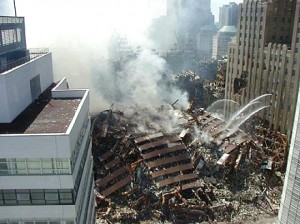2012-03-26: Let me lay out the problem this way … recently, after further developing and refining the definition of the term …
‘ The sequential growth and intensification of structural deformation and displacement, beyond fire engineering design parameters, and the eventual failure of elements of construction in a building – during a fire and the ‘cooling phase’ afterwards – which, if unchecked, will result in disproportionate damage, and may lead to total building collapse ‘
… our attention, in CIB W14’s Research Working Group IV, automatically turned towards the term itself. It didn’t sound right … it didn’t look right … and a lot of people in North America are still completely confused.
Was there anything we could do to clarify the situation ?
.
BACKGROUND
The long delay in incorporating the Recommendations of the following 2 Reports …
- NIST (National Institute of Standards and Technology). September 2005. Federal Building and Fire Safety Investigation of the World Trade Center Disaster: Final Report on the Collapse of the World Trade Center Towers. NIST NCSTAR 1. Gaithersburg, MD, USA.
and
- NIST (National Institute of Standards and Technology). August 2008. Federal Building and Fire Safety Investigation of the World Trade Center Disaster: Final Report on the Collapse of World Trade Center Building 7. NIST NCSTAR 1A. Gaithersburg, MD, USA.
… into building and fire codes/regulations, standards and administrative provisions at international, regional and national levels … can partly be explained by institutional inertia and the stubborn resistance of vested interests in the construction sector. To be fair, however, although both NIST Reports made extensive reference to the term ‘Fire-Induced Progressive Collapse’ … the structural concept was not defined, or elaborated, in either document. This was not really a task for NIST.
.
WHO IS CONFUSED ?
Since the publication of the 2005 NIST Report above, there has been much confusion about the term ‘Fire-Induced Progressive Collapse’.
Refer, for example, to the Introduction – Paragraph 1.1 on Page 1 – from NIST Document: ‘Best Practices for Reducing the Potential for Progressive Collapse in Buildings’ (NISTIR 7396 – February 2007) … where a lot of people, who should know better, really screwed up … and got it so wrong …
” The term ‘progressive collapse’ has been used to describe the spread of an initial local failure in a manner analogous to a chain reaction that leads to partial or total collapse of a building. The underlying characteristic of progressive collapse is that the final state of failure is disproportionately greater than the failure that initiated the collapse. ASCE Standard 7-05 defines progressive collapse as ‘the spread of an initial local failure from element to element resulting, eventually, in the collapse of an entire structure or a disproportionately large part of it’ (ASCE 2005). The disproportionality refers to the situation in which failure of one member causes a major collapse, with a magnitude disproportionate to the initial event. Thus, ‘progressive collapse’ is an incremental type of failure wherein the total damage is out of proportion to the initial cause. In some countries, the term ‘disproportionate collapse’ is used to describe this type of failure.
Based on the above description, it is proposed that the professional community adopt the following definition, which is based largely on ASCE 7-05:
progressive collapse – the spread of local damage, from an initiating event, from element to element resulting, eventually, in the collapse of an entire structure or a disproportionately large part of it; also known as disproportionate collapse.
The concept of progressive collapse can be illustrated by the famous 1968 collapse of the Ronan Point apartment building (Fig. 1-1). “
.

.
WE NOW KNOW
Fire-Induced Progressive Damage in Buildings is distinguished from Disproportionate Damage – a related but different structural concept – by the mode of damage initiation, not the final condition of building failure. Until this phenomenon is properly understood, and unless it is impeded, or resisted, by building design … Fire-Induced Progressive Damage will result in Disproportionate Damage … and may lead to a Collapse Level Event (CLE), which is entirely unacceptable to the general population of any community or society.
So … if unchecked, Fire-Induced Progressive Damage will lead to Disproportionate Damage.
BUT … while it may happen … which it did, when WTC Building 7 failed completely at approximately 17.21 hrs (local time) on the afternoon of 11 September 2001 in New York City … it is not necessarily always the case that Fire-Induced Progressive Damage and Disproportionate Damage will lead to Total Collapse.
.
OUR SOLUTION
In order to avoid the wide confusion which the term ‘Fire-Induced Progressive Collapse’ is continuing to cause at international level … the preferred term is now Fire-Induced Progressive Damage.
.
.
END

